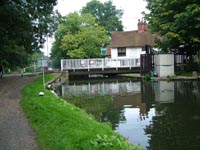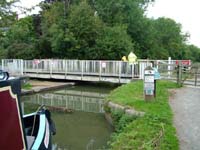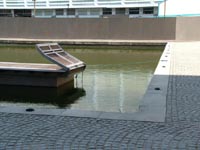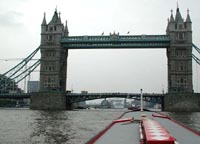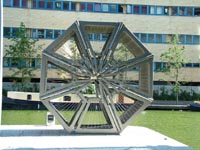A movable bridge is a structure which has been designed to have two alternative positions and which
can be moved back and forth between those positions in a controlled manner. The three primary purposes
of movable bridges are as a form of defense, to allow conflicting flows of traffic to pass through a
crossing point or to move traffic across a waterway.
The movable bridge may allow access for waterborne, rail, land vehicle or pedestrian traffic.
Movable bridges are constructed at points where the absence of a bridge or the use of a fixed bridge
would impede the flow of one form of traffic.
The term ‘swing bridge’ is often applied to small suspension bridges which tend to
oscillate or sway when pedestrians are crossing the bridge, although the bridge is in a fixed position.
These bridges are not movable bridges within the terms used in this web site and are not therefore included.
Lock gates on canals and waterways often have walkways across the top of the gate to allow operators
access between opposing banks. These have not been included in this study on the grounds that the primary
purpose of the structure is the control of the passage of water. This is to some extent an arbitrary
distinction but is deemed necessary to limit the size of the database, since there are probably thousands
of lock gate structures with walkways within the British Isles.
Swing Bridge – a swing bridge moves in the horizontal
plane about a pivot point, usually swinging through a 90
o arc.
The pivot point may be close to one end so that when swung into the open position to allow waterborne
traffic to pass the bridge deck lays close to or over the bank.
Alternatively the pivot point may be at the centre of the bridge so that when open the swing bridge
lies along the waterway and may offer clear passage for vessels along two channels. In some cases the
pivot point may be offset from the central point, creating asymmetric spans. In these types of swing
bridge there is often of necessity a control point on the bridge deck itself, since in most cases the
bridge deck is isolated from the shore when in the open position.
Swivel bridge - An alternate name used by some to describe a swing bridge, particularly
one which swings – or swivels – about a central point.
Lift Bridge - The deck of a lift bridge moves in the vertical plane, although it may not
move through a complete 90
o. There a variety of types of lift bridge.
Drawbridge - This is perhaps the oldest form of lift bridge, typically associated
with defensive fortifications. One end of the deck is fixed to a horizontal pivot point, with
ropes, cables or chains attached to the outer end and running up to a mechanism at the ‘fixed’ end. A winding mechanism allows the operator to wind the lines on to a drum, drawing the lifting end of
the bridge up into the air thus cutting off access from one side of the waterway, moat or deep ditch to
the other side.
Bascule - Bascule derives from the French word for ‘see-saw’,
describing the action of a bascule bridge. The weight of the long deck of the bridge is balanced
by an equal weight on the opposite end. By moving the weighted short end of the bridge downwards
the longer arm of the bridge deck is moved upwards around a horizontal axis, just as the weights
of two people sitting on opposite ends of a see-saw are moved by applying force alternately.
There are a variety of methods for creating the downward force to the counterweight. This can be
achieved by pumping fluid into a chamber, thus making that end of the bridge heavier, forcing it
down and raising the main deck. By pumping the fluid out again the deck is allowed to lower back
into position.
Counterweight - Similar in action to a bascule, but the balancing weight is a
fixed mass rather than fluid.
Vertical Lift - In this type of bridge both ends of the bridge deck are raised in
unison, so that the bridge deck itself remains in the horizontal position and traffic can pass
underneath. Unlike swing and bascule bridges this type of bridge does not give access to vessels
of unlimited size. Vessels are restricted to the maximum height to which the bridge deck can be
raised.
Transporter Bridge - A fairly rare type of bridge, although 4 examples survive
in the British Isles - 2 in working order in 2005. A cradle is slung beneath a taller structure.
The cradle is drawn from one side of the waterway to the other, carrying road or rail vehicles or
pedestrians.
Sliding, Retractable, Rolling - All three of these terms are used to describe a
moving bridge design in which the bridge deck remains in the same horizontal and vertical plane,
but is withdrawn from the waterway in a lateral movement. The term selected may reflect the means
by which the deck is moved.
Telescopic - In this type the bridge deck is withdrawn with one section being
drawn back inside the width of the next section.
Curling - A design in which the multiple sections of the bridge curl or roll up - achieved
by use of hydraulic rams.
Guillotine - I have seen this term used once or twice but have not yet found a
description of the mechanism nor had the opportunity to visit one myself to understand what the
term means when applied to a bridge.
Chain Pontoon - This is a borderline case between being a bridge or a ferry.
Pedestrians and or vehicles move onto a floating pontoon which is attached to cables. These are
then used to draw the pontoon across the waterway to the opposite bank. It is in effect a floating
transporter bridge. Many ferries operate on a similar principle, but I have excluded those in
which the power source for motion is on board the transporter vessel, at which point I have
decided the vessel becomes a boat controlled by chains or cables.
There is room for debate here on when a chain pontoon becomes a boat.
Caisson based lifts - Again these structures are on the borderline for
classification as bridges. In each type two water filled caissons are set to counterbalance each
other allowing vessels to be transferred between different levels with minimum effort.
Double Leaf - This refers to a bridge that has two sections that move - usually swing, lift or
bascule. There are two decks attached to opposite banks of the waterway. This allows smaller individual bridge
units to be used to span a wide channel, rather than having to build a much larger single span.
Manual - The bridge is moved by force of human effort, either simply by pulling
or pushing on the structure, or by operating a pulley or windlass system.
Hydraulic - Movement is created by pumping fluid - usually oil or water - into or out of a chamber
or chambers. In the case of a bascule bridge this creates motion by adding or removing weight from
one end of the structure. In some types of bridge motion is created by pumping fluid into a
cylinder forcing the piston within the cylinder to react.
Diesel, Electric, Steam, Diesel electric - These terms describe the motive power source used to
generate energy to be delivered to the operating mechanism.




